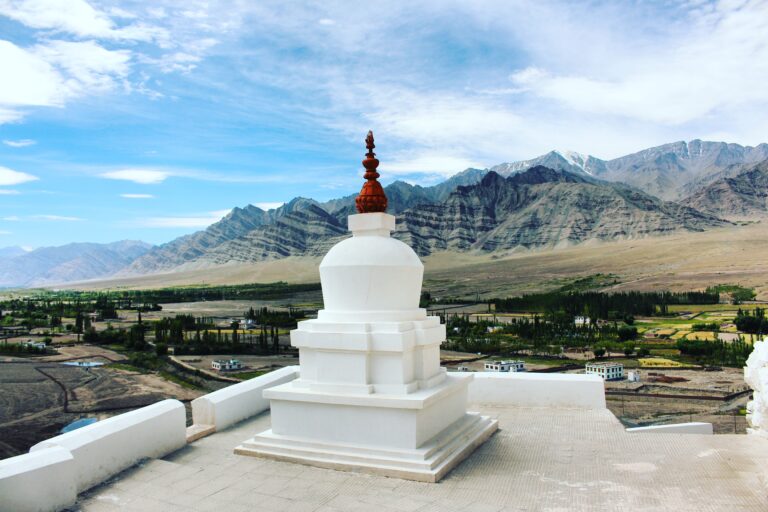On August 23 and 24, 2011, the museum opened to the public with a workshop, a special photographic show, and art installations by European artists. The festivities drew hundreds of people, including the Jammu and Kashmir Minister of Culture and Tourism as well as local community and administrative leaders.
The Tsa Soma park in the Chutayrangtak neighbourhood of ancient Leh is home to the Masjid Sharif, the oldest mosque in the city, which was restored in 2007 with the help of THF and the Anjuman Moin ul-Islam Society. The concept for the site’s future usage as a museum, the first of its kind in Leh, was devised with the support of Intach J&K. The goal was to educate the public on the role Ladakh played as a hub for Central Asian trade, which shaped the region’s distinctive culture over many generations.
In ancient Leh, the cornerstone of the new Central Asian Museum was laid on August 22. The museum was the vision of Saleem Beg of Intach J&K and the Anjuman Society in Leh (the site’s owner), with whom THF had worked in 2007 to rehabilitate Leh’s oldest mosque. The Government of Jammu and Kashmir is providing a sizable portion of the funding for this project, which also includes a library, a garden restaurant, and a museum shop. However, further monies will be needed to finish the building. Abdul Ghani Sheik, a renowned Ladakhi historian, is currently curating a permanent exhibition of trading relics.
THF/LOTI conceived and is constructing the museum. In April of 2008, a group of students from Berlin University of Technology’s Habitat Unit visited Leh to contribute to offering design ideas for the course on sustainable architecture for the Himalayan context. Additionally, two ASA/Invent exchange programme members were present. With the help of A. Catanese, S. Klein (THF/LOTI), N. Weber, B. Preller (ASA), local artisans masons Lal Singh and Jamyang, carpenter Tsering Dorje, the Anjuman team, and thanks to Professor Herrle, Professor Berten, A. Schubert, N.-A. Grzywatz, D. Krüger, André Alexander developed the final concept and design for the site (TU Berlin).

According to the museum’s overarching theme, the first floor’s ceiling is constructed in an early Ladakhi and Baltistani style. Typical of early Ladakhi temples, the capitals take inspiration from the Tsemo tower, while the central hall features a diamond roof.
The Jammu and Kashmir Ministry of Tourism, the China Exploration and Research Society (CERS), the Finnish Embassy in New Delhi, and Virginia and Wellington Yee all contributed to this project.
Events at the Central Asian Museum in Leh
Two seminars and an art show were co-hosted and co-organized by THF in conjunction with local organisations to mark the impending opening of the Central Asian Museum Leh (CAML) and the Trans-Himalayan Research Library (THRL).
Dedication of the Trans-Himalayan Library for Scientific Study
On June 9th, the Central Asian Museum Leh and its accompanying Trans-Himalayan Research Library opened to the public for the first time, following an official opening ceremony presided over by Saleem Beg (INTAC J&K). The library’s present focus is on scholarly works about the Himalayas and Central Asia, and it was founded on the personal collection of books provided by Ladakhi scholar Abdul Ghani Sheik. As a bonus, 80 kilogrammes of literature were given by the Sikkim Institute of Tibetology. Books are always welcome at THF, and any future gifts are greatly appreciated.
Cultural Heritage Conservation in Ladakh: A Future-Focused Workshop
The Trans-Himalaya Research Library hosted a workshop on the topic of “Conservation of Cultural Heritage & Its Future in Ladakh” on June 9. Architects Without Borders and The Human Foundation worked together on this workshop. The workshop, led by LAHDC, aimed to write comprehensive guidelines for heritage conservation in the Ladakhi region, to include the result in the vision statement for the year 2020. We anticipate the result will increase understanding of the need for cultural heritage conservation and serve as a check on hasty policies.
You’re Learning about Culture and Heritage in Ladakh should be accompanied by a stay that also includes heritage and culture, our heritage hotel in Ladakh has just what you need to enhance your appreciation for the cultural heritage of Ladakh.
Hans-Jorg Quaderer and Helena Becker: An Exhibition of Their Artwork
Hansjorg Quaderer and Helena Becker, two Liechtenstein artists, had an exhibit at the Central Asian Museum Leh in August. The celebration was meant to kick off activities that would heighten excitement for the museum’s opening. On display were several semi-abstract paintings on cloth and paper by Quaderer, created with pigments he discovered around the construction sites (charcoal from the fire, ochre from painting monastic walls, chalk for whitewashing, indigo, etc.). Inspired by the works of Sven Hedin and others, Helena Becker displayed a Leporello of twelve paper cuts based on the theme of Central Asian caravans.
Featured Image credits: vushii.com

